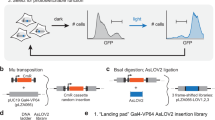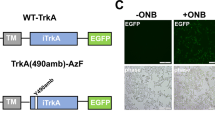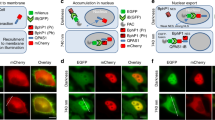Abstract
Control of protein activity in living cells can reveal the role of spatiotemporal dynamics in signaling circuits. Protein analogs with engineered allosteric responses can be particularly effective in the interrogation of protein signaling, as they can replace endogenous proteins with minimal perturbation of native interactions. However, it has been a challenge to identify allosteric sites in target proteins where insertion of responsive domains produces an allosteric response comparable to the activity of native proteins. Here, we describe a detailed protocol to generate genetically encoded analogs of proteins that can be allosterically controlled by either rapamycin or blue light, as well as experimental procedures to produce and test these analogs in vitro and in mammalian cell lines. We describe computational methods, based on crystal structures or homology models, to identify effective sites for insertion of either an engineered rapamycin-responsive (uniRapR) domain or the light-responsive light–oxygen–voltage 2 (LOV2) domain. The inserted domains allosterically regulate the active site, responding to rapamycin with irreversible activation, or to light with reversible inactivation at higher spatial and temporal resolution. These strategies have been successfully applied to catalytic domains of protein kinases, Rho family GTPases, and guanine exchange factors (GEFs), as well as the binding domain of a GEF Vav2. Computational tasks can be completed within a few hours, followed by 1–2 weeks of experimental validation. We provide protocols for computational design, cloning, and experimental testing of the engineered proteins, using Src tyrosine kinase, GEF Vav2, and Rho GTPase Rac1 as examples.
This is a preview of subscription content, access via your institution
Access options
Access Nature and 54 other Nature Portfolio journals
Get Nature+, our best-value online-access subscription
$29.99 / 30 days
cancel any time
Subscribe to this journal
Receive 12 print issues and online access
$259.00 per year
only $21.58 per issue
Buy this article
- Purchase on Springer Link
- Instant access to full article PDF
Prices may be subject to local taxes which are calculated during checkout






Similar content being viewed by others
References
Dagliyan, O. et al. Engineering extrinsic disorder to control protein activity in living cells. Science 354, 1441–1444 (2016).
Karginov, A. V. et al. Dissecting motility signaling through activation of specific Src-effector complexes. Nat. Chem. Biol. 10, 286–290 (2014).
Chu, P. H. et al. Engineered kinase activation reveals unique morphodynamic phenotypes and associated trafficking for Src family isoforms. Proc. Natl. Acad. Sci. USA 111, 12420–12425 (2014).
Ostermeier, M. Designing switchable enzymes. Curr. Opin. Struct. Biol. 19, 442–448 (2009).
Oakes, B. L. et al. Profiling of engineering hotspots identifies an allosteric CRISPR-Cas9 switch. Nat. Biotechnol. 34, 646–651 (2016).
Edwards, W. R., Busse, K., Allemann, R. K. & Jones, D. D. Linking the functions of unrelated proteins using a novel directed evolution domain insertion method. Nucleic Acids Res. 36, e78 (2008).
Inoue, T., Do Heo, W., Grimley, J. S., Wandless, T. J. & Meyer, T. An inducible translocation strategy to rapidly activate and inhibit small GTPase signaling pathways. Nat. Methods 2, 415–418 (2005).
Bayle, J. H. et al. Rapamycin analogs with differential binding specificity permit orthogonal control of protein activity. Chem. Biol. 13, 99–107 (2006).
Spencer, D. M., Wandless, T. J., Schreiber, S. L. & Crabtree, G. R. Controlling signal-transduction with synthetic ligands. Science 262, 1019–1024 (1993).
Karginov, A. V., Ding, F., Kota, P., Dokholyan, N. V. & Hahn, K. M. Engineered allosteric activation of kinases in living cells. Nat. Biotechnol. 28, 743–747 (2010).
Dagliyan, O. et al. Engineering Pak1 allosteric switches. ACS Synth. Biol. 6, 1257–1262 (2017).
Tucker, C. L. & Fields, S. A yeast sensor of ligand binding. Nat. Biotechnol. 19, 1042–1046 (2001).
Dagliyan, O. et al. Rational design of a ligand-controlled protein conformational switch. Proc. Natl. Acad. Sci. USA 110, 6800–6804 (2013).
Banaszynski, L. A., Chen, L. C., Maynard-Smith, L. A., Ooi, A. G. L. & Wandless, T. J. A rapid, reversible, and tunable method to regulate protein function in living cells using synthetic small molecules. Cell 126, 995–1004 (2006).
Bonger, K. M., Chen, L. C., Liu, C. W. & Wandless, T. J. Small-molecule displacement of a cryptic degron causes conditional protein degradation. Nat. Chem. Biol. 7, 531–537 (2011).
Kennis, J. T. et al. Primary reactions of the LOV2 domain of phototropin, a plant blue-light photoreceptor. Biochemistry 42, 3385–3392 (2003).
Peter, E., Dick, B. & Baeurle, S. A. Mechanism of signal transduction of the LOV2-Jα photosensor from Avena sativa. Nat. Commun. 1, 122 (2010).
Harper, S. M., Neil, L. C. & Gardner, K. H. Structural basis of a phototropin light switch. Science 301, 1541–1544 (2003).
Wu, Y. I. et al. A genetically encoded photoactivatable Rac controls the motility of living cells. Nature 461, 104–108 (2009).
Wang, X. B., He, L., Wu, Y. I., Hahn, K. M. & Montell, D. J. Light-mediated activation reveals a key role for Rac in collective guidance of cell movement in vivo. Nat. Cell Biol. 12, 591–597 (2010).
Hayashi-Takagi, A. et al. Labelling and optical erasure of synaptic memory traces in the motor cortex. Nature 525, 333–338 (2015).
Guo, X. M., Liao, Z. H., Tao, Y. Z., Wang, F. F. & Ma, L. [Optogenetic activation of dorsal hippocampal astrocytic Rac1 blocks the learning of associative memory]. Sheng Li Xue Bao 69, 241–251 (2017).
Das, A., Dines, M., Alapin, J. M. & Lamprecht, R. Affecting long-term fear memory formation through optical control of Rac1 GTPase and PAK activity in lateral amygdala. Sci. Rep. 7, 13930 (2017).
Mills, E., Chen, X., Pham, E., Wong, S. & Truong, K. Engineering a photoactivated caspase-7 for rapid induction of apoptosis. ACS Synth. Biol. 1, 75–82 (2012).
Pham, E., Mills, E. & Truong, K. A synthetic photoactivated protein to generate local or global Ca2+ signals. Chem. Biol. 18, 880–890 (2011).
Schierling, B. & Pingoud, A. Controlling the DNA cleavage activity of light-inducible chimeric endonucleases by bidirectional photoactivation. Bioconjug. Chem. 23, 1105–1109 (2012).
Renicke, C., Schuster, D., Usherenko, S., Essen, L. O. & Taxis, C. A LOV2 domain-based optogenetic tool to control protein degradation and cellular function. Chem. Biol. 20, 619–626 (2013).
Baarlink, C., Wang, H. C. & Grosse, R. Nuclear actin network assembly by formins regulates the SRF coactivator MAL. Science 340, 864–867 (2013).
Rao, M. V., Chu, P. H., Hahn, K. M. & Zaidel-Bar, R. An optogenetic tool for the activation of endogenous diaphanous-related formins induces thickening of stress fibers without an increase in contractility. Cytoskeleton 70, 394–407 (2013).
Rivera-Cancel, G., Motta-Mena, L. B. & Gardner, K. H. Identification of natural and artificial DNA substrates for light-activated LOV-HTH transcription factor EL222. Biochemistry 51, 10024–10034 (2012).
Wang, X., Chen, X. & Yang, Y. Spatiotemporal control of gene expression by a light-switchable transgene system. Nat. Methods 9, 266–269 (2012).
Liang, F. S., Ho, W. Q. & Crabtree, G. R. Engineering the ABA plant stress pathway for regulation of induced proximity. Sci. Signal. 4, rs2 (2011).
Miyamoto, T. et al. Rapid and orthogonal logic gating with a gibberellin-induced dimerization system. Nat, Chem. Biol. 8, 465–470 (2012).
Yazawa, M., Sadaghiani, A. M., Hsueh, B. & Dolmetsch, R. E. Induction of protein-protein interactions in live cells using light. Nat. Biotechnol. 27, 941–945 (2009).
Guntas, G. et al. Engineering an improved light-induced dimer (iLID) for controlling the localization and activity of signaling proteins. Proc. Natl Acad. Sci. 112, 112–117 (2015).
Kennedy, M. J. et al. Rapid blue-light-mediated induction of protein interactions in living cells. Nat. Methods 7, 973–975 (2010).
Levskaya, A., Weiner, O. D., Lim, W. A. & Voigt, C. A. Spatiotemporal control of cell signalling using a light-switchable protein interaction. Nature 461, 997–1001 (2009).
Wang, H. et al. LOVTRAP: an optogenetic system for photoinduced protein dissociation. Nat. Methods 13, 755-758 (2016).
Lee, S. et al. Reversible protein inactivation by optogenetic trapping in cells. Nat. Methods 11, 633–636 (2014).
Taslimi, A. et al. An optimized optogenetic clustering tool for probing protein interaction and function. Nat. Commun. 5, 4925 (2014).
Zhou, X. X., Chung, H. K., Lam, A. J. & Lin, M. Z. Optical control of protein activity by fluorescent protein domains. Science 338, 810–814 (2012).
Zayner, J. P. & Sosnick, T. R. Factors that control the chemistry of the LOV domain photocycle. PLoS ONE 9, e87074 (2014).
Kanwar, M., Wright, R. C., Date, A., Tullman, J. & Ostermeier, M. Protein switch engineering by domain insertion. Methods Enzymol. 523, 369–388 (2013).
Aydin, Z., Altunbasak, Y. & Borodovsky, M. Protein secondary structure prediction for a single-sequence using hidden semi-Markov models. BMC Bioinformatics 7, 178 (2006).
Yang, J. et al. The I-TASSER Suite: protein structure and function prediction. Nat. Methods 12, 7–8 (2015).
Webb, B. & Sali, A. Comparative protein structure modeling using MODELLER. Curr. Protoc. Protein Sci. 86, 2.9.1–2.9.37 (2016).
Alford, R. F. et al. The Rosetta all-atom energy function for macromolecular modeling and design. J. Chem. Theory Comput. 13, 3031–3048 (2017).
Heinig, M. & Frishman, D. STRIDE: a web server for secondary structure assignment from known atomic coordinates of proteins. Nucleic Acids Res. 32, W500–W502 (2004).
Finn, R. D. et al. Pfam: the protein families database. Nucleic Acids Res. 42, D222–D230 (2014).
Simonetti, F. L., Teppa, E., Chernomoretz, A., Nielsen, M. & Marino Buslje, C. MISTIC: mutual information server to infer coevolution. Nucleic Acids Res. 41, W8–W14 (2013).
Karginov, A. V. et al. Light regulation of protein dimerization and kinase activity in living cells using photocaged rapamycin and engineered FKBP. J. Am. Chem. Soc. 133, 420–423 (2011).
Garcia-Mata, R. et al. Analysis of activated GAPs and GEFs in cell lysates. Methods Enzymol. 406, 425–437 (2006).
Slattery, S. D. & Hahn, K. M. A high-content assay for biosensor validation and for examining stimuli that affect biosensor activity. Curr. Protoc. Cell Biol. 65, 14.15.1–14.15.31 (2014).
Tsygankov, D. et al. CellGeo: a computational platform for the analysis of shape changes in cells with complex geometries. J. Cell Biol. 204, 443–460 (2014).
Tsygankov, D., Chu, P. H., Chen, H., Elston, T. C. & Hahn, K. M. User-friendly tools for quantifying the dynamics of cellular morphology and intracellular protein clusters. Methods Cell Biol. 123, 409–427 (2014).
Barry, D. J., Durkin, C. H., Abella, J. V. & Way, M. Open source software for quantification of cell migration, protrusions, and fluorescence intensities. J. Cell Biol. 209, 163–180 (2015).
Roy, A., Kucukural, A. & Zhang, Y. I-TASSER: a unified platform for automated protein structure and function prediction. Nat. Protoc. 5, 725–738 (2010).
Lyons, P. D., Dunty, J. M., Schaefer, E. M. & Schaller, M. D. Inhibition of the catalytic activity of cell adhesion kinase beta by protein-tyrosine phosphatase-PEST-mediated dephosphorylation. J. Biol. Chem. 276, 24422–24431 (2001).
Ramachandran, S., Kota, P., Ding, F. & Dokholyan, N. V. Automated minimization of steric clashes in protein structures. Proteins 79, 261–270 (2011).
Machacek, M. et al. Coordination of Rho GTPase activities during cell protrusion. Nature 461, 99–103 (2009).
Yan, R., Xu, D., Yang, J., Walker, S. & Zhang, Y. A comparative assessment and analysis of 20 representative sequence alignment methods for protein structure prediction. Sci. Rep. 3, 2619 (2013).
Acknowledgements
This work was supported by NIH grants R35GM122596 (K.M.H.), and R01-GM114015, R01-GM064803, and R01-GM123247 (N.V.D).
Author information
Authors and Affiliations
Contributions
O.D. developed and optimized the protocol with input from N.V.D and K.M.H. O.D. wrote the protocol with input from K.M.H.
Corresponding author
Ethics declarations
Competing interests
The authors declare no competing interests.
Additional information
Publisher’s note: Springer Nature remains neutral with regard to jurisdictional claims in published maps and institutional affiliations.
Related links
Key references using this protocol
Dagliyan, O. et al. Science 354, 1441–1444 (2016): https://doi.org/10.1126/science.aah3404
Karginov, A. V. et al. Nat. Chem. Biol. 10, 286–290 (2014): https://doi.org/10.1038/nchembio.1477
Dagliyan, O. et al. Proc. Natl Acad. Sci. USA 110, 6800–6804 (2013): https://doi.org/10.1073/pnas.1218319110
Dagliyan, O. et al. ACS Synth. Biol. 6, 1257–1262 (2017): https://doi.org/10.1021/acssynbio.6b00359
Karginov, A. V., Ding, F., Kota, P., Dokholyan, N. V. & Hahn, K. M. Nat. Biotechnol. 28, 743–747 (2010): https://doi.org/10.1038/nbt.1639
Chu, P.-H. et al. PNAS 111, 12420–12425 (2014): https://doi.org/10.1073/pnas.1404487111
Rights and permissions
About this article
Cite this article
Dagliyan, O., Dokholyan, N.V. & Hahn, K.M. Engineering proteins for allosteric control by light or ligands. Nat Protoc 14, 1863–1883 (2019). https://doi.org/10.1038/s41596-019-0165-3
Received:
Accepted:
Published:
Issue Date:
DOI: https://doi.org/10.1038/s41596-019-0165-3
This article is cited by
-
Designed allosteric protein logic
Cell Discovery (2024)
-
Engineering and exploiting synthetic allostery of NanoLuc luciferase
Nature Communications (2022)
-
Metal-responsive regulation of enzyme catalysis using genetically encoded chemical switches
Nature Communications (2022)
-
Two-input protein logic gate for computation in living cells
Nature Communications (2021)
-
Rational design and implementation of a chemically inducible heterotrimerization system
Nature Methods (2020)
Comments
By submitting a comment you agree to abide by our Terms and Community Guidelines. If you find something abusive or that does not comply with our terms or guidelines please flag it as inappropriate.



